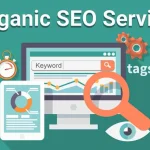Now Reading: What is SEO?
- 01
What is SEO?
What is SEO?

Introduction
In today’s digital landscape, where millions of websites compete for attention, understanding SEO—or Search Engine Optimization—can be a game changer. Have you ever wondered how some websites consistently appear at the top of search results while others remain hidden in the depths of the internet? The answer is often found in effective SEO strategies. In this guide, we’ll explore what SEO is, why it’s essential, and how you can harness its power to elevate your online presence.
Whether you’re a business owner, a marketer, or simply curious about digital trends, this article will walk you through the basics of SEO, dive into its components, and offer actionable insights to help you optimize your website. Let’s get started!
Table of contents

Understanding SEO: The Basics
Definition of SEO
SEO stands for Search Engine Optimization. In simple terms, it’s the process of enhancing your website so that it ranks higher in search engine results pages (SERPs) like Google, Bing, and Yahoo. When your site ranks higher, it’s more likely to be visited by users searching for relevant topics, products, or services.
Imagine SEO as a roadmap guiding search engines to your website. The better the roadmap, the easier it is for search engines to find, understand, and recommend your content to users.
History and Evolution of SEO
SEO isn’t a modern fad; it has evolved significantly over the past two decades. In the early days of the internet, SEO was largely about stuffing keywords and exploiting loopholes in search engine algorithms. However, as search engines became smarter, so did the techniques required to rank well. Today, modern SEO emphasizes quality content, user experience, and ethical strategies.
From simple keyword placement to a complex blend of technical improvements, content creation, and backlink strategies, the evolution of SEO mirrors the growth of the internet itself. It’s fascinating to see how a practice that once relied on tricks now demands expertise, precision, and creativity.
The Importance of SEO
Role in Digital Marketing
SEO is a cornerstone of digital marketing. Think of it as the foundation upon which your online marketing efforts are built. Whether you’re running pay-per-click (PPC) campaigns, social media ads, or email marketing, SEO works behind the scenes to ensure that your website is visible when it matters most.
Have you ever wondered why some websites get more organic traffic than others? The answer lies in how well they’ve implemented SEO strategies. Without a solid SEO plan, even the best products or services might go unnoticed.
Benefits for Businesses and Websites
Effective SEO can transform your online presence. Here are some of the major benefits:
- Increased Visibility: Higher rankings mean more eyeballs on your website.
- Cost-Effective Marketing: Organic traffic is free, reducing the need for expensive ad campaigns.
- Enhanced User Experience: Good SEO practices often improve site usability, making it easier for visitors to navigate.
- Credibility and Trust: Websites that rank well are often perceived as more authoritative and trustworthy.
- Higher Conversion Rates: When your website attracts the right audience, conversions tend to improve, whether that means more sales, leads, or subscribers.
Core Components of SEO
To understand SEO fully, it’s crucial to break it down into its main components. Effective SEO combines on-page, off-page, and technical elements to create a robust strategy.
On-Page SEO
On-page SEO refers to the strategies implemented directly on your website to improve its visibility and relevance. Here’s a closer look:
Keyword Research and Content Optimization
Keyword research is the process of identifying the terms and phrases your target audience uses when searching online. Once you know what they’re looking for, you can create content that answers their questions. It’s like tuning a radio to the right frequency—when you get it right, the signal (or in this case, your content) reaches exactly the right people.
Optimizing content involves incorporating these keywords naturally within your articles, blog posts, and other content types. However, it’s not just about sprinkling keywords around; quality and relevance matter more than sheer volume.
Title Tags, Meta Descriptions, and Internal Linking
Every page on your website has a title tag and meta description that tells search engines—and potential visitors—what the page is about. Crafting compelling, keyword-rich titles and descriptions can significantly improve click-through rates from SERPs.
Internal linking, on the other hand, involves linking to other relevant pages on your site. This not only helps users navigate your website but also aids search engines in understanding the structure and hierarchy of your content.
Off-Page SEO
Off-page SEO focuses on activities outside your website that influence your ranking. The most critical aspect here is link building.
Link Building and Backlinks
Backlinks are like votes of confidence from other websites. When reputable sites link to yours, it signals to search engines that your content is valuable and trustworthy. It’s similar to how a recommendation from a friend can carry more weight than an advertisement.
However, not all backlinks are created equal. Quality matters far more than quantity. A few links from highly authoritative sites can be far more beneficial than numerous links from lesser-known sources.
Social Signals and Online Reputation
In addition to backlinks, social media activity plays a role in SEO. When your content is shared widely across platforms like Facebook, Twitter, and LinkedIn, it can indirectly boost your search rankings. Social signals indicate engagement and relevance, which search engines increasingly take into account.
Technical SEO
Technical SEO deals with the non-content elements of your website, ensuring that it meets the technical requirements of modern search engines.
Site Architecture and Mobile-Friendliness
A well-organized site structure is critical for both user experience and search engine crawlers. A clear, logical architecture makes it easier for search engines to index your pages and for users to find what they’re looking for.
With the growing use of mobile devices, having a mobile-friendly website is no longer optional—it’s a necessity. Google and other search engines prioritize mobile responsiveness, ensuring that users have a seamless experience across all devices.
Site Speed, Security, and Crawlability
Site speed is a major factor in user satisfaction. A slow-loading website can frustrate users and lead to higher bounce rates. On the technical side, ensuring your site is secure (using HTTPS) and easy for search engines to crawl can make a significant difference in your rankings.
SEO Strategies and Best Practices
Now that we’ve covered the fundamental components of SEO, let’s explore some strategies and best practices that can help you get ahead.
Content Marketing and SEO
Content is king in the digital realm. Creating high-quality, relevant, and engaging content is one of the most effective ways to improve your SEO. It’s not just about filling your website with words; it’s about providing value. Think of your content as a conversation with your audience—informative, friendly, and engaging.
Blog posts, videos, infographics, and podcasts can all contribute to a comprehensive content marketing strategy. By consistently producing great content, you can attract more visitors, build credibility, and naturally earn backlinks.
Local SEO Strategies
For businesses with a physical presence, local SEO is indispensable. Local SEO focuses on optimizing your online presence to attract customers in your geographic area. This includes creating a Google My Business profile, optimizing for local keywords, and encouraging customer reviews.
Local SEO ensures that when someone searches for services “near me,” your business is among the first to appear. It’s like being the friendly neighborhood store everyone knows and trusts.
Voice Search Optimization
With the rise of smart speakers and voice assistants, optimizing for voice search is becoming increasingly important. Voice searches are often more conversational and longer than traditional text searches. To adapt, focus on natural language, FAQs, and content that directly answers common queries.
Measuring and Analyzing SEO Success
Tracking your SEO performance is crucial to understand what works and what needs improvement.
Key Metrics and SEO Tools
There are several key metrics you should monitor, such as organic traffic, bounce rate, conversion rate, and keyword rankings. SEO tools like Google Analytics, SEMrush, Ahrefs, and Moz can provide valuable insights into your website’s performance.
By regularly analyzing these metrics, you can adjust your strategies, optimize your content, and ultimately achieve better results. Think of it as regularly checking the health of your website—small tweaks can lead to significant improvements over time.
Tracking and Reporting Techniques
Creating regular SEO reports helps you visualize progress and identify trends. Whether you’re doing it weekly, monthly, or quarterly, detailed reporting allows you to measure the impact of your SEO efforts and make data-driven decisions. Use graphs, charts, and clear summaries to communicate your progress effectively.
Common SEO Challenges and How to Overcome Them
Even the most seasoned SEO professionals face challenges. Here are some common hurdles and practical ways to overcome them.
Navigating Algorithm Updates
Search engines frequently update their algorithms to provide users with better search results. While these updates can sometimes disrupt your rankings, staying informed and adapting your strategies is key. Rather than chasing every new trend, focus on creating quality content and maintaining ethical SEO practices.
Think of algorithm updates as weather changes—you can’t control them, but you can certainly prepare for them by having a robust strategy and backup plans.
Avoiding Black Hat SEO Tactics
While shortcuts like keyword stuffing and link farming might yield short-term gains, they can lead to long-term penalties. Black hat SEO practices risk your website’s credibility and can result in being penalized or even de-indexed by search engines. Instead, invest in ethical, white-hat strategies that build sustainable growth over time.
The Future of SEO
SEO is a constantly evolving field. Staying ahead means anticipating future trends and adapting your strategies accordingly.
Emerging Trends in Search Optimization
The future of SEO is exciting, with trends like mobile-first indexing, semantic search, and augmented reality search experiences on the horizon. As technology evolves, so will the way we search for information. Keeping up with these trends can give you a competitive edge and ensure your strategies remain effective.
The Impact of AI and Machine Learning on SEO
Artificial intelligence and machine learning are transforming SEO in profound ways. From automated content creation to predictive analysis, AI is helping marketers make smarter decisions. Tools powered by AI can analyze vast amounts of data, identify patterns, and provide insights that were previously unimaginable. Embracing these technologies can not only streamline your SEO efforts but also deliver highly personalized experiences to your users.
Conclusion
SEO is more than just a buzzword—it’s a fundamental aspect of digital success. By understanding its components, implementing ethical strategies, and staying updated with emerging trends, you can unlock the full potential of your online presence. Whether you’re a seasoned marketer or just starting out, remember that SEO is an ongoing journey, not a one-time fix.
Think of SEO as tending a garden. You need to nurture it continuously with quality content, technical care, and strategic planning. The more effort you put into it, the more you’ll see it flourish, bringing in visitors, customers, and long-term success.
Frequently Asked Questions (FAQs)
SEO, or Search Engine Optimization, is the process of improving your website’s visibility on search engine results pages. It involves optimizing content, technical elements, and external signals to ensure your site appears higher in search rankings.
SEO is not an overnight success. Depending on factors like competition, the quality of your content, and the effectiveness of your strategy, it can take several months to start seeing significant improvements in rankings and traffic.
While search engine algorithms are complex, some key factors include high-quality content, mobile-friendliness, site speed, backlinks, and a solid on-page optimization strategy.
Absolutely! SEO can level the playing field for small businesses by helping them reach local customers and compete with larger companies without the need for huge advertising budgets.
SEO is dynamic, so it’s important to regularly review and adjust your strategies. Staying informed about algorithm changes and industry trends, along with routine performance audits, can ensure your SEO efforts remain effective.























